Norbiton (24)
By:
May 14, 2021
Anatomy of Norbiton: Labyrinthine
One jar of honey to all the gods, one jar of honey to the Mistress of the Labyrinth.”
Knossos, tablet, Linear B
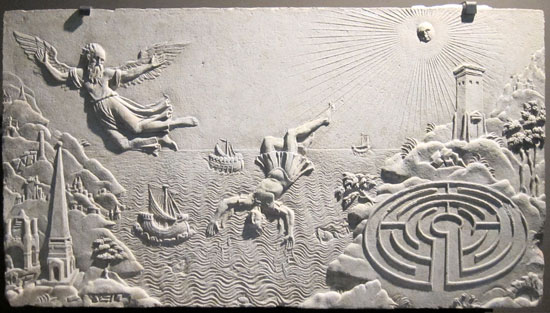
– FALL OF ICARUS
17TH CENTURY, MUSÉE ANTOINE VIVENEL
Some deaths are linear; others are labyrinthine.
In some the journey of the soul is straight, direct, if necessarily troubled. Thus it crosses water, negotiates passage with beasts and guardian spirits. Perhaps there is an antechamber, a nervous wait. But the door will open and the souls will stream in. There is nothing to be done.
In others the passage from life to death is convoluted, retrograde, baffling. There is no clear way forward, and no clear way back. The soul lingers purgatorially, on an ontological cusp, murmuring incantations, trying old half-forgotten combinations, fumbling with map and compass, straining for a peak or pinnacle from which to get a clear view, take a reading, a dead-reckoning, fetch down a signal.
In the Ideal City no progress is linear, direct. Its geometrical underlay is curved, folded, strange. And if we no longer pray for the soul or suffering of the dying and deceased, then we do recognise that there are rituals to be discharged. Rituals such as the treading of a labyrinth.
And this is apt, because in a world of floating signifiers—city, labyrinth, soul—it goes without saying that NORBITON: IDEAL CITY is the acme of melancholical labyrinths.
A labyrinth is an open signifier, it can be whatever you wish it to be; but in many cultures it is an apotropaic device laid out to protect your bit of space—your city, your town, your settlement, your house; in short, your little plain of being—from the dead. The dead are baffled by a labyrinth. Their steps are sluggish, widdershins, benighted. Their forays into the land of the living, the plane of light, are brief. They are easily discouraged.
But it is a two-way gate. If you in your turn are to pass successfully to the underworld at the appointed time, you need to know how to tread the maze. Not everyone does: some defer, others delay, or shilly-shally, and when they come to it they do not hit the right path. And those who fail are eaten by guardian beasts.
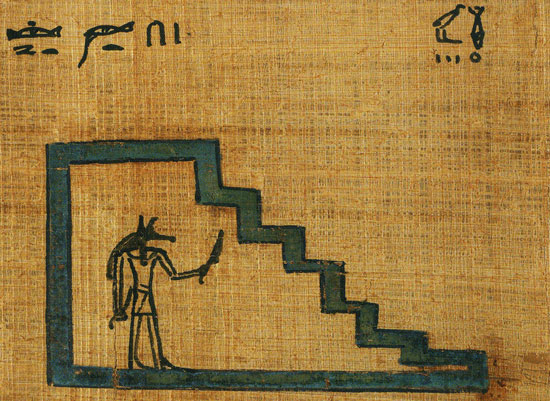
– THE MOUNDS OF THE NETHERWORLD FROM THE BOOK OF THE DEAD OF NU, ELEVENTH MOUND
Labyrinths can be UNICURSAL or they can be MULTICURSAL. In a unicursal maze you can take no wrong turn. You follow the form inscribed in the landscape, to the centre if there is one, and then out again. The labyrinths laid out to protect the living from the dead, the earliest example of which perhaps date from the Neolithic, are unicursal. The bafflement is all in the routing, the recursus, the wandering, meandering return.
The unicursal labyrinth comes in various forms.
The Cretan form is found on coins from Knossos or on ancient potsherds, but analogous versions are scratched in rock faces at Neolithic sites, or built into turf mazes in seventeenth century England or stone mazes along the coastlines of Scandinavia. It is also linked to labyrinthine forms from India to the South Seas.
The Roman form is essentially a derivation or repetition of the Cretan topology, with perhaps some needful variation in the fourth quadrant as the path veers to the centre, and an occasional augmentation or doubling of the pattern.
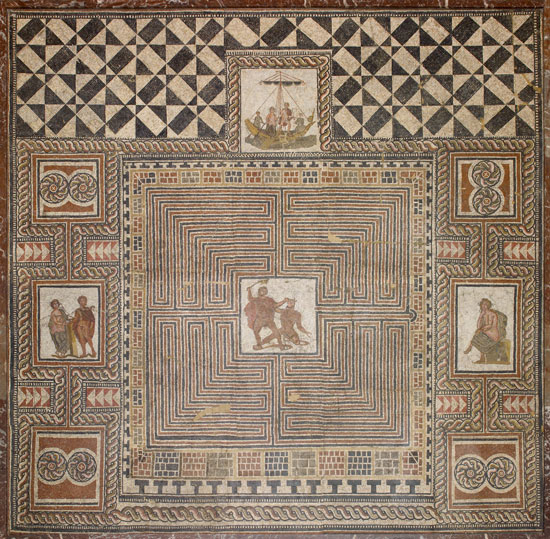
– THESEUS MOSAIC
300-400 AD
The medieval form is often found at the entrance to the nave of churches and cathedrals—Chartres being a notable but by no means unique example—where they retained their apotropaic value, but also mimicked Christ’s descent into Hell and return therefrom (Theseus was typologically identified with Christ in the Middle Ages).
A multicursal labyrinth is a labyrinth of forking paths. Its intention is to baffle you. It is a puzzle. Where you seem most to make progress, you most retreat. Or at any rate, the harder it is to return.
Multicursal labyrinths are sometimes called mazes, to distinguish them from unicursal labyrinths, but the distinction is spurious. Through every multicursal labyrinth, or maze, there is a single unicursal path. The apparent choices are not real choices because they lead to dead ends. They are a mere conceit, a wil’o’th’wisp, an involuted ornamental overlay.
In the Garden of Forking Paths, a story published by Jorge Luis Borges in 1941, the protagonist makes his way through a labyrinthine garden in pursuit of a labyrinthine text in order that he may send a playfully coded message across the fractured labyrinth of war-torn European space-time; but he is closely pursued and knows he is closely pursued by the agent of his own inevitable death. Indeed, his death (in a labyrinth) is the message. The structure of the labyrinthine text at issue in the story may echo the structure of the universe; but there is still only one path to be trodden.
Choice is an emblem of freedom, not a mechanism of it. The living of a life does not resolve itself into strict choices, but pulsing fields of ill-defined, superpositioned possibilities, most of which will never be resolved. When you are offered the semblance of a choice, then should you most suspect your liberty.
Hunter Sidney does not believe that when he dies he will be expected to tread an underworld labyrinth, but he says that the approaches to his own death are of a not unpleasing unicursal form. There is no more anxiety about forking paths and illusory possibilities. It is a matter of a solemn winding tread, certain evolutions, entirely predictable and determined both in the grand scheme of things and in the petty detail.
He is negotiating the final ornamental borders of his life. It pleases him to think, he says, that your life is divided into rooms or cells, time spent in a given place, or house, or relationship, or job. And as you enter and leave each of these rooms you cross a hyper-patterned zone, a sort of abstract space in which your mental state alters. Once you are properly inside a given cell, or once you leave it properly behind, life is what it is, with its various attributes; but each cell, occupied or empty, is framed with more intensely patterned ornament, a transitional field where the figurative images are dissolved into their repetitive, patterned constituent elements.
And the field of ornament grows most dense, involuted, intricate and universal as you approach death. Your perception of pattern is acute. All those crucified gods and suffering virgins, all that drama and narrative, become irrelevant, or marginal. You find yourself wishing you had lived your whole life in this state of curious uncertainty, this delighted tracing of patterns.
Ornamental borders in the Renaissance favour vegetal design over geometric forms. Geometric rationality is expressed in chequerboard floors and some egg-and-dart moulding, but on the whole the borderland of renaissance art and architecture, like its gothic European predecessors, is fecund, mutable, vegetal, grotesque. If borderlands between spaces (in art or architecture) have some relic apotropaic function, then they exercise it by representing the wildwood.
The Greeks and the Romans had available to them, however, a properly geometrical labyrinthine design, the GREEK KEY or MEANDER. The Romans in particular were fond of it, and used it for floor mosaic, particularly at the entrance to dwellings where its apotropaic and baffling qualities could be brought into play.
Owen Jones, in his Grammar of Ornament (1856), distinguishes the simpler fret from the compound meander.
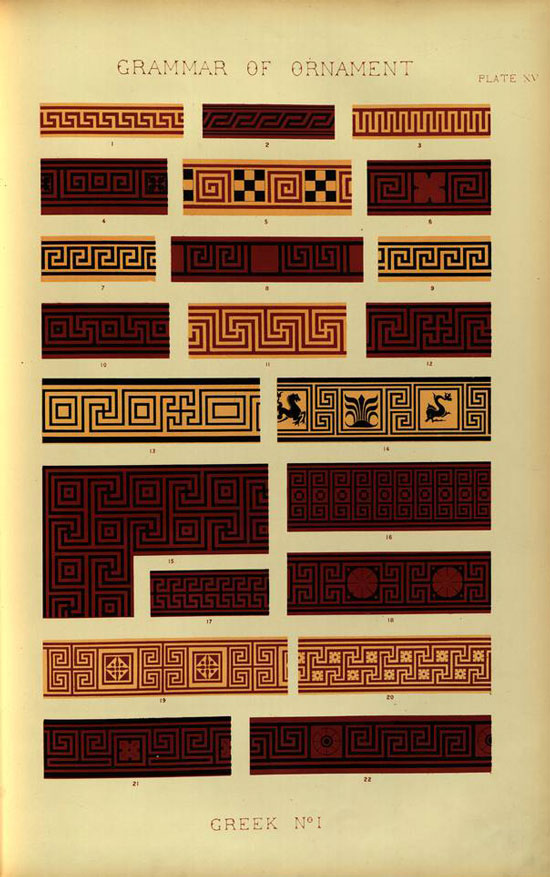
– GREEK I, GRAMMAR OF ORNAMENT
OWEN JONES
In a meander, properly understood, the double fret will begin to interlace, it takes on the appearance if not the topological properties of a multicursal labyrinth.
Even the simple fret, however, has impeccable labyrinthine credentials.[1] It is the root or fundamental form of the Cretan Laybrinth, characterised by a stepwise retrograde motion, a recursus. As you progress, so do you return. If a multicursal labyrinth draws you steadily in, a unicursal labyrinth sends you back the way you came.
You do not need to pass over an ornamental border to look at a picture or shift your gaze from one field of a pot to the next; they are impassable borders only because there is no continuum between the viewer, standing outside the picture, and the Madonna, locked inside it. The labyrinthine border, the Greek Key, the gilt picture frame, is merely a form of punctuation.
Clarke says this is true of all labyrinths; they purport to be conduits through which we must pass, connecting different states of being—say, life and death, or adolescence and adulthood; but in reality they are merely ideal forms, projections of the mind. Ways of coping. The only ontological state is the here and now. It is a commonplace that life is a journey, and that journeys are labyrinths or rollercoasters; but life in fact is a profound stasis. It is. And then it isn’t. It doesn’t matter if you think you are going round in circles, or in a straight line.
It is the same, he says with cities. Cities are often described as labyrinths, places of exchange—economic, cultural—where you choose among the myriad forking paths in pursuit of your own advancement. But in fact they are static agglomerations. There is no route to the centre, only accidental and illusory whorls and path-like forms, meaningless local eddies captured in stone.
You are dumped in a corner of the city, tied by powerful conventions of work and rent to a small flat or house where you fiddle with your things and your hobbies and your interpersonal relations. You go nowhere. There is nowhere to go. The freedoms which seem to emerge as though by star-like forces and pressures at its centre—the easy movement of money, luxury and adulation—are illusions. It is you who are under pressure, hallucinating other possibilities in the deep and currentless ocean.

– PORTRAIT OF A MAN
BARTOLOMEO VENETO
What Clarke is describing, although he appears insensible of the fact, is only a single point in the labyrinth, not the labyrinth as a whole; specifically, a dead-end in a multicursal labyrinth. You have twisted and turned and forked your way around the maze, and now sit down in a confused rage and conclude that the deception is not local but general. There is no centre. There is no goal.
To have constructed and inhabited an Ideal City, however, is to have posited a centre. The city might be corrupted, gravitationally compromised, its streets might buckle and twist, its vectors and networks intertwine; but the experience of a city is that it has a centre, a logic, and an answer.
Perhaps to agrarian or nomadic people the bronze age towns, concentrations of despotic power and armed men, conspicuous wealth and slave-castes, were labyrinths, labyrinths of stone and bureaucracy, with at their heart, squatting on the grain store and coiled around the heaps of mined and refined metal, a bellowing suffering king who would rend you limb from hapless limb should you ever penetrate that far.
Not only are cities described as labyrinths, but labyrinths are described as cities—and not just as cities but as fallen cities. They are known as Troy-towns, or in Scandinavia as Troyaborg or Troyaburg, or Trojborg. An early representation of a labyrinth on an Etruscan oenochoe from Tragliatella, dated to around 620 BCE, shows horsemen issuing from a Labyrinth-City marked TRUIA.
In Northern Europe, in addition to Troy, they were often named in association with Biblical cities of uncertain fate—Jericho, or Nineveh. In the Old Testament Book of Nahum, which mostly concerns itself with the destruction of Nineveh, that city is described as being as broad as a three-day journey, which might be true of the historical Nineveh if a unicursal winding through all the streets of the city were intended.
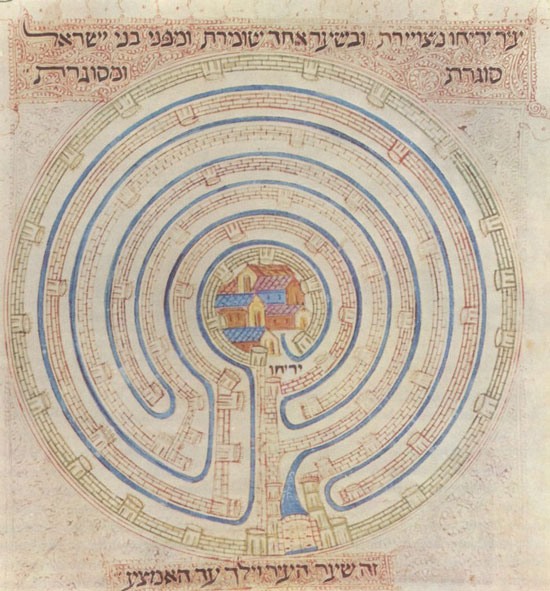
– JERICHO
ELISHA BEN AVRAHAM CRESCAS, FARHI BIBLE
I suggest to Clarke—an expression, perhaps, of a subconscious desire to dislodge him from my sofa—that we organise such a walk across Norbiton: plot a unicursal path along all its streets and tread it out. It could be, I say, our Hunter Sidney memorial walk.
Clarke reminds me that we have not yet completed the circumambulation. And that Hunter Sidney is still with us.
He is right. But I remain convinced that the association of labyrinths and cities is not an historical accident. It is a ritual necessity. The Labyrinth-City in its detached form may have become just another floating signifier, a useless and irksome bit of intellectual flotsam, but there is no doubt that cities when they appeared, with their shanty-town compression, their alleys and noise and disease, their walls and their gates and their gardens and their fountains, were rapidly subsumed into the pre-existing symbolical landscapes of megaliths and barrows; they became, by adoption or transference, powerful operators in a symbolical system, as well as powerful operators in an economic and imperial system; and to assuage that power, both sorts of power, it is necessary to learn their steps, tread them out, neutralise them.
‘It must have been as great a relief for men of the times as it is for us today to escape from the crowded, narrow, crooked streets into the immense open and ordered spaces within one of these palaces.’
Richard Goldthwaite, The Building of Renaissance Florence (1982) p. 103
Hunter Sidney says that at the centre of the labyrinth you find a modicum of meditative space.
Technically, we know this to be incorrect, because labyrinths do not have centres as such: they have generative nuclei.
That is to say, it is the (posited, imagined) centre which determines the fundamental form of the labyrinth, the unravelled key to it; in pursuing a labyrinth to its centre you are also pursuing it to its origin, you are pursuing it to the point of explanation.
If we move more surely as we approach the centre, it is because the centre has generated the path in the first place, and is reeling us in.
I like to think of Hunter Sidney playing chess with his Lady of the Labyrinth, Mrs Isobel Easter, to whose garden I conducted him one afternoon after lunch, even though I know this did not happen.
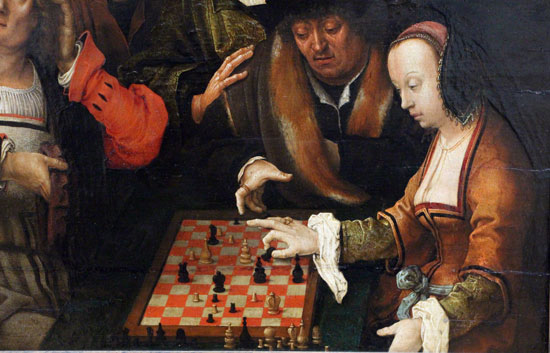
– THE CHESS GAME
LUCAS VAN LEYDEN
I like to think it because Hunter Sidney gives me little else to go on. He tells me nothing about what was said, or how he was received. But he does, a day or two later, say this in connection with the meeting: when you arrive at what you suppose to be the centre of a labyrinth, and therefore at its end, you expect, subconsciously, that all possibility will be closed off, just as all choice is closed off; but while you have no choices, no options, possibility is laid bare behind you, a tiny parcel of infinity.
It is like this, he says. At the centre, there is an octagonal kiosk—a pavilion of the limpid solitude. On a table in that pavilion you find a chequered board, a board for a game you know (say, draughts); but the pieces are for a game you have never played and never even heard of (say, chess); and there is a basic set of rules; and if this were eternity, you would have an infinity of time, in which you could be assured that one version of the game you play will be, not just chess, but the whole history of chess from Ruy Lopez to Deep Blue; but you do not have an eternity; you have only a matter of hours; so you feel no pressure, no urge to start.
The chessboard is a non-labyrinthine, coordinate space. The satisfaction lies, not in the promise that you will explore everything; but in knowing how you are situated, now, and at any point up to now.
The Neolithic populations of Britain and Ireland were fond of their Great Public Works. They dragged menhirs up hills, built henges and barrows and pallisade ditches and timber causeways. And between 3800/3600 and about 3000 BCE, they built cursuses, great ceremonial straight roads or courses formed of parallel ditches and banked up earth which cut across the landscape for mile after mile.
It is not known what purpose they served, or how they interacted with the ritual landscape; they may have been barriers between ceremonial and occupation landscapes, for instance, not facilitating but hindering movement.
However, in a world filled with natural mazes and labyrinths—forests and woods, mountainous regions, marshes or bogs, deserts; the cyclic return of the sun and the seasons, the circuit of life and death—they are clearly a paradigm of the anti-labyrinth.
In such a world they provide a direct path. They divide the landscape into clearly defined zones. They are evidence of a great civic yearning for simplicity and clarity.
A city is a natural labyrinth overlaying a natural maze; it is a bewildering maze of possibilities shot through with habitual necessary unvarying paths. I am occasionally tempted by a fragmentary vision of NORBITON: IDEAL CITY in which it is graced with great boulevards of sanity, open undeviating routes and spaces where its citizens can gather and disperse, untrammelled, uncoerced.
But I know that Haussmann built his boulevards for crowd control; that those great rational cursuses of the Neolithic were anything but rational; they were built insanely and trodden by a terrified people.
No. All rising to a great place is by a winding stair, said Sir Francis Bacon; and Sir Thomas Browne spoke of the hill and asperous road that leadeth unto the house of sanity. Perhaps the insane winding, the restless incompleteness, the frustration of the twisted land is a kinetic human motor; the maze is our natural environment, one in which we are safe, one to which, forlorn ambitious arboreals, we are ultimately native. Lay out a straight path and, if we do not end by machine-gunning the populace, we will simply wander off it; lay out a chessboard and we will invent draughts. Restless bewilderment, it seems, is our only recourse, our only liberty.
Footnotes ☞
1 As pointed out for example by Karl Kerényi in “Labyrinth-Studien” 1966 In Humanistische Seelen-Forschung, 226-73. Munich. ⏎
Anatomy of Norbiton on HILOBROW
Original post at Anatomy of Norbiton: Labyrinthine
Anatomy of Norbiton
Short Life in a Strange World by Toby Ferris
Toby Ferris on Twitter
On the Paintings of Pieter Bruegel by Toby Ferris
All tapir illustrations by Anna Keen: portfolio

